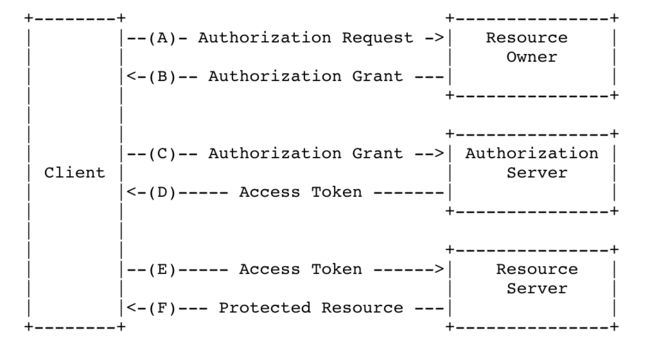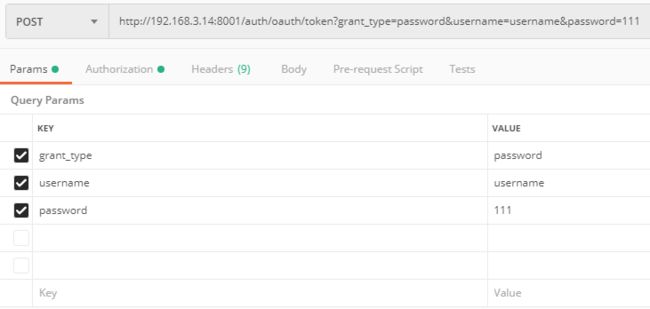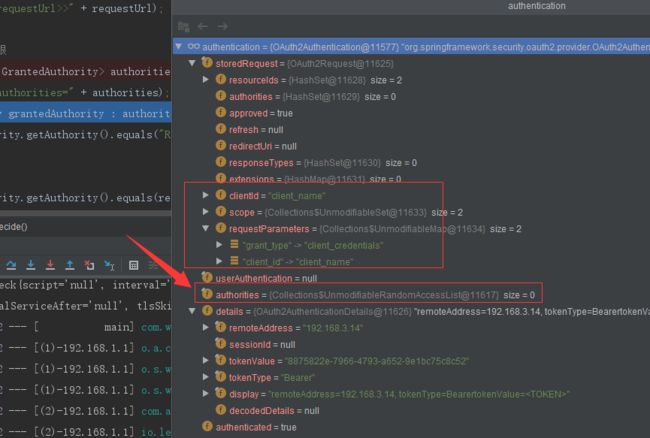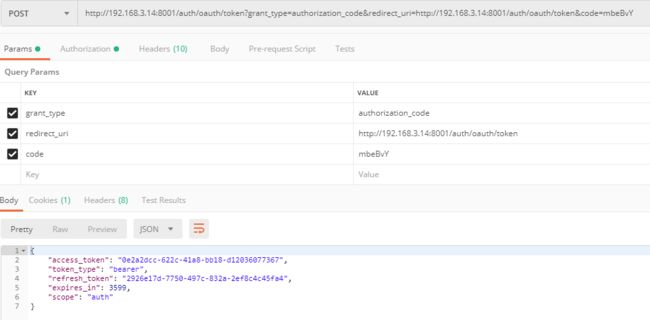最近项目准备使用SpringSecurityOAuth2做权限认证管理,所以先了解一下SpringSecurityOAuth的使用原理并做一个demo做参考
GitHub地址
码云地址
一、项目知识准备
-
什么是OAuth2
OAuth 2.0 的标准是 RFC 6749 文件 OAuth 引入了一个授权层,用来分离两种不同的角色:客户端和资源所有者。......资源所有者同意以后,资源服务器可以向客户端颁发令牌。客户端通过令牌,去请求数据:
-
OAuth2核心-授权
-
OAuth2的四种方式
| 模式 |
|---|
| 授权码(authorization-code) |
| 隐藏式(implicit) |
| 密码式(password) |
| 客户端凭证(client credentials) |
4. 握手流程(摘自RFC6749)
5. SpringSecurity
基于Spring的企业应用系统提供声明式的安全訪问控制解决方式的安全框架(简单说是对访问权限进行控制嘛),应用的安全性包括用户认证(Authentication)和用户授权(Authorization)两个部分
*6. SpringSecurity 中默认的内置过滤列表:
(其他后续补充)
二、项目准备
1. 环境
SpringBoot 2.1.0.RELEASE jdk1.8 SpringCloud Greenwich.SR1 consul服务发现与注册
- 项目
| 项目 | 描述 |
|---|---|
| fp-commons | jar公用 |
| fp-gateway | 网关 |
| fp-authorization-server | OAuth2认证服务器 |
| 3. 项目搭建 |
(1)网关搭建 frame-gateway
pom.xml:
引入依赖文件;在启动器上添加 注册监听@EnableDiscoveryClient
并注入 DiscoveryClientRouteDefinitionLocator
application.xml:
spring-main-allow-bean-definition-overriding: true (相同名称注入允许覆盖)
spring.application.name:SpringCloud-consul-gateway (设置应用名称必须)
bootstrap.yml 中配置 consul(比application先加载)
prefer-ip-address: true (使用ip注册,有些网络会出现用主机名来获取注册的问题)
(2)fp-commons jar公用
pom.xml:
引入依赖文件;添加一些公用方法
(3)fp-authorization-server
(git中提交了一个至简版本的OAuth2认证中心,只有token生成功能,没有资源保护以及认证)
只需要配置AuthorizationServerConfigurerAdapter 认证服务器
以及WebSecurityConfigurerAdapter SpringSecurity配置 两个文件,就能实现token生成。
如果没有需要保护的资源不用ResourceServerConfigurerAdapter 资源服务器配置
三、认证服务器搭建
基本的SpringBoot搭建略过,这里只介绍SpringSecurity OAuth2的token实现,基本的数据处理以及其他看源码。
首先完成ClientDetailsService的自定义实现(获取客户端相关信息)
/**
* @Description 自定义客户端数据
* @Author wwz
* @Date 2019/07/28
* @Param
* @Return
*/
@Service
public class MyClientDetailsService implements ClientDetailsService {
@Autowired
private AuthClientDetailsMapper authClientDetailsMapper;
@Override
public ClientDetails loadClientByClientId(String clientId) throws ClientRegistrationException {
AuthClientDetails clientDetails = authClientDetailsMapper.selectClientDetailsByClientId(clientId);
if (clientDetails == null) {
throw new ClientRegistrationException("该客户端不存在");
}
MyClientDetails details = new MyClientDetails(clientDetails);
return details;
}
}
以及UserDetailsService的自定义实现(获取用户相关信息)
/**
* @Description 自定义用户验证数据
* @Author wwz
* @Date 2019/07/28
* @Param
* @Return
*/
@Service
public class MyUserDetailsService implements UserDetailsService {
@Autowired
private AuthUserMapper authUserMapper;
@Override
public UserDetails loadUserByUsername(String username) throws UsernameNotFoundException {
// 自定义用户权限数据
AuthUser authUser = authUserMapper.selectByUsername(username);
if (authUser == null) {
throw new UsernameNotFoundException("用户名不存在");
}
if (!authUser.getValid()) {
throw new UsernameNotFoundException("用户不可用");
}
Set grantedAuthorities = new HashSet<>();
if (authUser.getAuthRoles() != null) {
for (AuthRole role : authUser.getAuthRoles()) {
// 当前角色可用
if (role.getValid()) {
//角色必须是ROLE_开头
GrantedAuthority grantedAuthority = new SimpleGrantedAuthority(role.getRoleName());
grantedAuthorities.add(grantedAuthority);
if (role.getAuthPermissions() != null) {
for (AuthPermission permission : role.getAuthPermissions()) {
// 当前权限可用
if (permission.getValid()) {
// 拥有权限设置为 auth/member/GET 可以访问auth服务下面 member的查询方法
GrantedAuthority authority = new SimpleGrantedAuthority(permission.getServicePrefix() + "/" + permission.getUri() + "/" + permission.getMethod());
grantedAuthorities.add(authority);
}
}
}
}
//获取权限
}
}
MyUserDetails userDetails = new MyUserDetails(authUser, grantedAuthorities);
return userDetails;
}
}
然后新建认证服务配置MySecurityOAuth2Config,继承AuthorizationServerConfigurerAdapter
/**
* @Description OAuth2认证服务配置
* @Author wwz
* @Date 2019/07/28
* @Param
* @Return
*/
@Configuration
@EnableAuthorizationServer
public class MySecurityOAuth2Config extends AuthorizationServerConfigurerAdapter {
@Autowired
private AuthenticationManager authenticationManager; // 认证方法入口
@Autowired
private RedisConnectionFactory connectionFactory; // redis连接工厂
@Autowired
private MyUserDetailsService userDetailsService; // 自定义用户验证数据
@Autowired
private MyClientDetailsService clientDetailsService; // 自定义客户端数据
// 加密方式
@Bean
public PasswordEncoder passwordEncoder() {
return new BCryptPasswordEncoder();
}
/***
* 设置token用redis保存
*/
@Bean
public TokenStore tokenStore() {
//token保存在redis中(也可以保存在数据库、内存中new InMemoryTokenStore()、或者jwt;)。
//如果保存在中间件(数据库、Redis),那么资源服务器与认证服务器可以不在同一个工程中。
//注意:如果不保存access_token,则没法通过access_token取得用户信息
RedisTokenStore redis = new RedisTokenStore(connectionFactory);
return redis;
}
/**
* 配置令牌端点(Token Endpoint)的安全约束
*/
@Override
public void configure(AuthorizationServerSecurityConfigurer oauthServer) throws Exception {
oauthServer
.tokenKeyAccess("permitAll()")
.checkTokenAccess("isAuthenticated()")
.allowFormAuthenticationForClients(); // 允许表单登录
}
/**
* 配置 oauth_client_details【client_id和client_secret等】信息的认证【检查ClientDetails的合法性】服务
* 设置 认证信息的来源:数据库,内存,也可以自己实现ClientDetailsService的loadClientByClientId 方法自定义数据源
* 自动注入:ClientDetailsService的实现类 JdbcClientDetailsService (检查 ClientDetails 对象)
* 这个方法主要是用于校验注册的第三方客户端的信息,可以存储在数据库中,默认方式是存储在内存中
*/
@Override
public void configure(ClientDetailsServiceConfigurer clients) throws Exception {
// 设置从自定义接口获取客户端信息
clients.withClientDetails(clientDetailsService);
// clients.inMemory() // 使用in-memory存储
// .withClient("client_name") // client_id
// .secret(passwordEncoder().encode("111")) // client_secret
// .redirectUris("http://localhost:8001")
// // 该client允许的授权类型
// .authorizedGrantTypes("password", "authorization_code", "refresh_token", "client_credentials")
// .scopes("app", "app1", "app3"); // 允许的授权范围
}
/**
* 配置授权(authorization)以及令牌(token)的访问端点和令牌服务(token services)
*/
@Override
public void configure(AuthorizationServerEndpointsConfigurer endpoints) throws Exception {
endpoints
.tokenStore(tokenStore()) // 配置token存储
.userDetailsService(userDetailsService) // 配置自定义的用户权限数据,不配置会导致token无法刷新
.authenticationManager(authenticationManager)
.tokenServices(defaultTokenServices()); // 加载token配置
}
/**
* 把认证的token保存到redis
* 注意,自定义TokenServices的时候,需要设置@Primary,否则报错,
* 自定义的token
* 认证的token是存到redis里的 若ClientDetails中设定了有效时间则以设定值为准
*/
@Primary
@Bean
public DefaultTokenServices defaultTokenServices() {
DefaultTokenServices tokenServices = new DefaultTokenServices();
tokenServices.setTokenStore(tokenStore());
tokenServices.setSupportRefreshToken(true);
tokenServices.setClientDetailsService(clientDetailsService);
tokenServices.setAccessTokenValiditySeconds(60 * 60 * 12); // token有效期自定义设置,默认12小时
tokenServices.setRefreshTokenValiditySeconds(60 * 60 * 24 * 7); // refresh_token默认30天
return tokenServices;
}
}
接着新建Security的配置MySecurityConfig 继承WebSecurityConfigurerAdapter
**
* @Description security 配置
* ResourceServerConfigurerAdapter 是比WebSecurityConfigurerAdapter 的优先级低的
* @Author wwz
* @Date 2019/07/28
* @Param
* @Return
*/
@Configuration
@EnableWebSecurity
@Order(2) // WebSecurityConfigurerAdapter 默认为100 这里配置为2设置比资源认证器高
public class MySecurityConfig extends WebSecurityConfigurerAdapter {
// 自定义用户验证数据
@Bean
public MyUserDetailsService userDetailsService() {
return new MyUserDetailsService();
}
// 加密方式
@Bean
public PasswordEncoder passwordEncoder() {
return new BCryptPasswordEncoder();
}
// 验证器加载
@Override
@Bean
public AuthenticationManager authenticationManagerBean() throws Exception {
return super.authenticationManagerBean();
}
@Override
protected void configure(HttpSecurity http) throws Exception {
http
// 匹配oauth相关,匹配健康,匹配默认登录登出 在httpSecurity处理,,其他到ResourceServerConfigurerAdapter OAuth2处理 1
.requestMatchers().antMatchers("/oauth/**", "/actuator/health", "/login", "/logout")
.and()
// 匹配的全部无条件通过 permitAll 2
.authorizeRequests().antMatchers("/oauth/**", "/actuator/health", "/login", "/logout").permitAll()
// 匹配条件1的 并且不再条件2通过范围内的其他url全部需要验证登录
.and().authorizeRequests().anyRequest().authenticated()
// 启用登录验证
.and().formLogin().permitAll();
// 不启用 跨站请求伪造 默认为启用, 需要启用的话得在form表单中生成一个_csrf
http.csrf().disable();
}
@Override
protected void configure(AuthenticationManagerBuilder auth) throws Exception {
auth.userDetailsService(userDetailsService()).passwordEncoder(passwordEncoder());
}
}
到此,SpringSecurity OAuth2至简的项目搭建完成,下一步为4种token的基本验证
四、4种token获取(这里使用postman做token获取)
- password模式认证
请求地址:
http://192.168.3.14:8001/auth/oauth/token?grant_type=password&username=username&password=111
参数:
| 参数名 | 说明 |
|---|---|
| grant_type | 类型必须为password |
| username | 用户名 |
| password | 密码 |
| client_id | 客户端id |
| client_serce | 客户端密码 |
| 请求: |
响应: 返回信息 包括 access_token 通行token, refresh_token 重新申请token,scope资源范围 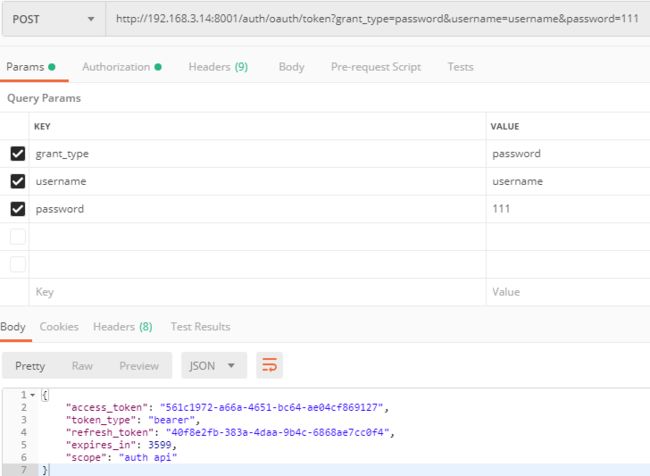
验证:
无权访问页面
访问页面
- client_credentials模式
请求地址:
http://192.168.3.14:8001/auth/oauth/token?grant_type=client_credentials&client_id=client_name&client_secret=111
参数:
| 参数名 | 说明 |
|---|---|
| grant_type | 类型必须为client_credentials |
| client_id | 客户端id |
| client_serce | 客户端密码 |
| 请求 |
响应:返回参数 包括access_token,scope 权限范围 (但是不包含refresh_token) 
验证:默认无任何权限 当然,这里的权限也可以在ClientDetails中的authorities字段中默认增加权限
-
refresh_token 模式
refresh_token 只有请求过一次并且获取到refresh_token才能用该值重新申请可用token,并且,申请了新的token后,原先为过期的token立即失效,refresh_token作为新的token的refresh_token继续使用。
请求地址:
http://192.168.3.14:8001/auth/oauth/token?grant_type=refresh_token&refresh_token=384b02e7-66d5-4d5b-8179-53793f7ba40b
参数
| 参数名 | 说明 |
|---|---|
| grant_type | 类型必须为refresh_token |
| refresh_token | 刷新token |
请求:
响应:返回结果包括 新的token,原refresh_token,scope权限 
- authorization_code模式
请求:
第一次请求:http://192.168.3.14:8001/auth/oauth/authorize?response_type=code&client_id=client_name&redirect_uri=http://192.168.3.14:8001/auth/oauth/token&scope=auth
第二次请求:http://192.168.3.14:8001/auth/oauth/token?grant_type=authorization_code&redirect_uri=http://192.168.3.14:8001/auth/oauth/token&code=mbeBvY
参数:
第一次参数
| 参数名 | 说明 |
|---|---|
| response_type | 类型必须为code |
| client_id | 客户端id |
| redirect_uri | 返回code地址 与后端client_Id对应 redirect_uri,与第二步请求token对应 |
第二次参数
| 参数名 | 说明 |
|---|---|
| grant_type | 类型必须为authorization_code |
| code | 为返回code 这里为 mbeBvY |
| redirect_uri | 返回code地址 上一步redirect_uri http://192.168.3.14:8001/auth/oauth/token |
上述,填错一个就会报错code只能使用一次 再次请求失效
第一次请求后跳转 登录界面
登录后跳转授权页面然后返回到携带的redirect_uri路径 并带上code
第二次请求
响应:返回结果包括 token, refresh_token,scope权限


